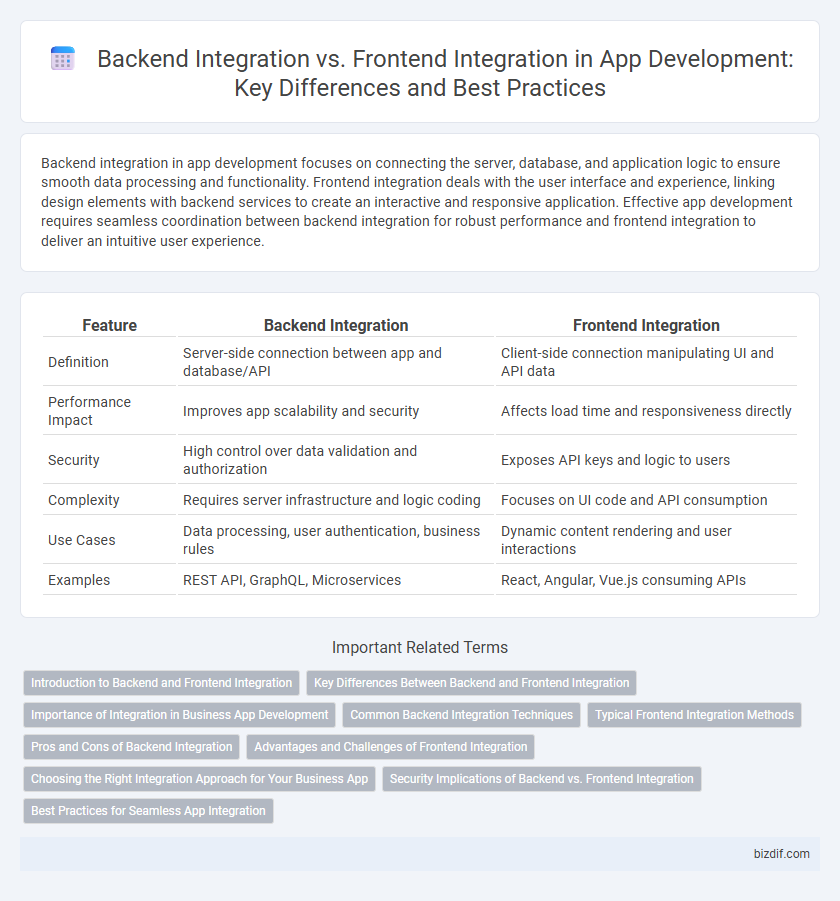Backend integration in app development focuses on connecting the server, database, and application logic to ensure smooth data processing and functionality. Frontend integration deals with the user interface and experience, linking design elements with backend services to create an interactive and responsive application. Effective app development requires seamless coordination between backend integration for robust performance and frontend integration to deliver an intuitive user experience.
Table of Comparison
| Feature | Backend Integration | Frontend Integration |
|---|---|---|
| Definition | Server-side connection between app and database/API | Client-side connection manipulating UI and API data |
| Performance Impact | Improves app scalability and security | Affects load time and responsiveness directly |
| Security | High control over data validation and authorization | Exposes API keys and logic to users |
| Complexity | Requires server infrastructure and logic coding | Focuses on UI code and API consumption |
| Use Cases | Data processing, user authentication, business rules | Dynamic content rendering and user interactions |
| Examples | REST API, GraphQL, Microservices | React, Angular, Vue.js consuming APIs |
Introduction to Backend and Frontend Integration
Backend integration involves connecting server-side systems, databases, and APIs to ensure smooth data flow and business logic execution, critical for app functionality and performance. Frontend integration focuses on linking user interfaces with backend services, enabling dynamic content rendering and interactive user experiences. Understanding the synergy between backend and frontend integration is essential for developing responsive, scalable, and efficient applications.
Key Differences Between Backend and Frontend Integration
Backend integration involves connecting server-side logic, databases, and APIs to ensure data processing and storage, while frontend integration focuses on linking user interfaces with backend services to enable dynamic content and interactions. Key differences include backend integration handling data management, authentication, and business logic, whereas frontend integration deals with rendering, user experience, and responsiveness. Backend integration relies heavily on technologies like Node.js, Python, or Ruby, while frontend integration uses frameworks such as React, Angular, or Vue.js to bind data and UI components.
Importance of Integration in Business App Development
Seamless backend integration ensures robust data management and server-side functionality critical for business app performance, while frontend integration focuses on delivering an intuitive user interface and enhanced user experience. Effective synchronization between backend APIs and frontend components increases app reliability, scalability, and responsiveness, directly impacting user satisfaction and operational efficiency. Prioritizing integration strategies in business app development accelerates time-to-market and supports dynamic feature updates, driving competitive advantage.
Common Backend Integration Techniques
Common backend integration techniques in app development include RESTful APIs, allowing seamless data exchange between frontend and backend systems. GraphQL offers efficient querying by enabling clients to request specific data fields, reducing over-fetching. Webhooks facilitate real-time communication by pushing updates from the backend to the frontend, ensuring synchronized user experiences.
Typical Frontend Integration Methods
Typical frontend integration methods in app development include RESTful APIs, GraphQL, and WebSocket connections to ensure seamless communication with backend services. These methods enable dynamic content rendering, real-time updates, and interactive user interfaces by efficiently fetching and managing data from backend servers. Leveraging frontend frameworks like React, Angular, or Vue.js further optimizes integration by facilitating component-based architecture and state management.
Pros and Cons of Backend Integration
Backend integration offers robust data management and enhanced security by centralizing business logic and database interactions, making it ideal for complex applications requiring scalable architecture. It allows seamless connectivity with APIs and third-party services, improving data consistency and reducing client-side processing load. However, backend integration can increase development complexity and time, demanding skilled backend developers and potentially introducing latency compared to frontend integration techniques.
Advantages and Challenges of Frontend Integration
Frontend integration enhances user experience by enabling dynamic, interactive interfaces directly connected to backend services, ensuring real-time data updates and responsive design. Challenges include managing complex state synchronization, ensuring seamless API communication, and maintaining cross-browser compatibility without compromising performance. Optimizing frontend integration requires advanced JavaScript frameworks, robust error handling, and efficient resource loading to deliver smooth, scalable applications.
Choosing the Right Integration Approach for Your Business App
Selecting the right integration approach for your business app depends heavily on project requirements and scalability needs. Backend integration supports complex data processing, security, and centralized control, making it ideal for apps requiring robust performance and real-time updates. Frontend integration enhances user experience with faster interactions and dynamic content rendering, best suited for applications prioritizing responsive design and immediate visual feedback.
Security Implications of Backend vs. Frontend Integration
Backend integration offers enhanced security by handling sensitive data and business logic on secure servers, reducing exposure to client-side vulnerabilities such as cross-site scripting (XSS) and data tampering. Frontend integration, while enabling dynamic user interfaces and real-time data updates, increases the risk of security breaches due to its exposure to the client environment and reliance on secure API communication. Effective security strategies prioritize backend validation, secure authentication mechanisms, and encryption to mitigate risks associated with frontend integration points.
Best Practices for Seamless App Integration
Backend integration ensures robust data management and secure API communication, which forms the foundation for seamless app performance. Frontend integration focuses on creating responsive user interfaces and smooth user experiences by effectively consuming backend services through optimized API calls. Best practices include maintaining clear data contracts, using standardized protocols like REST or GraphQL, and implementing error handling to synchronize frontend and backend functionalities efficiently.
Backend integration vs Frontend integration Infographic

 bizdif.com
bizdif.com